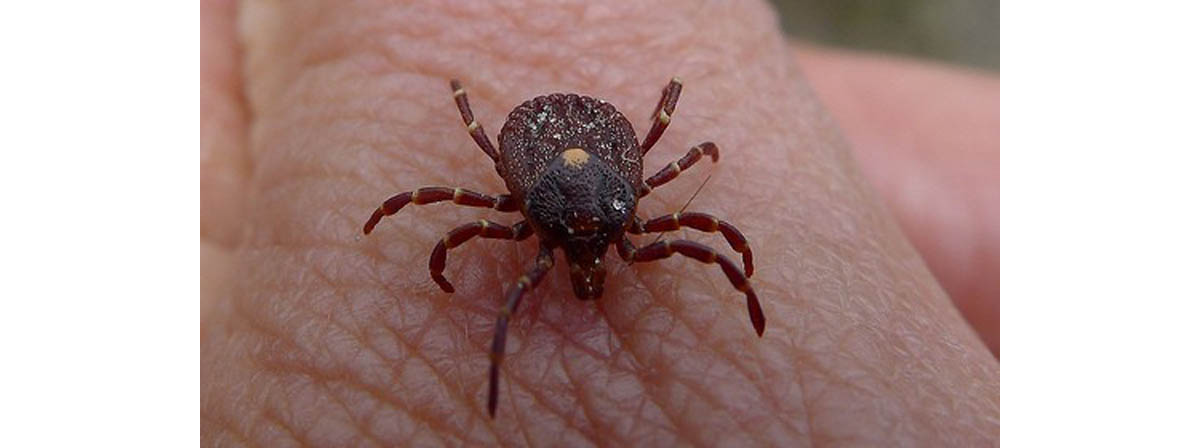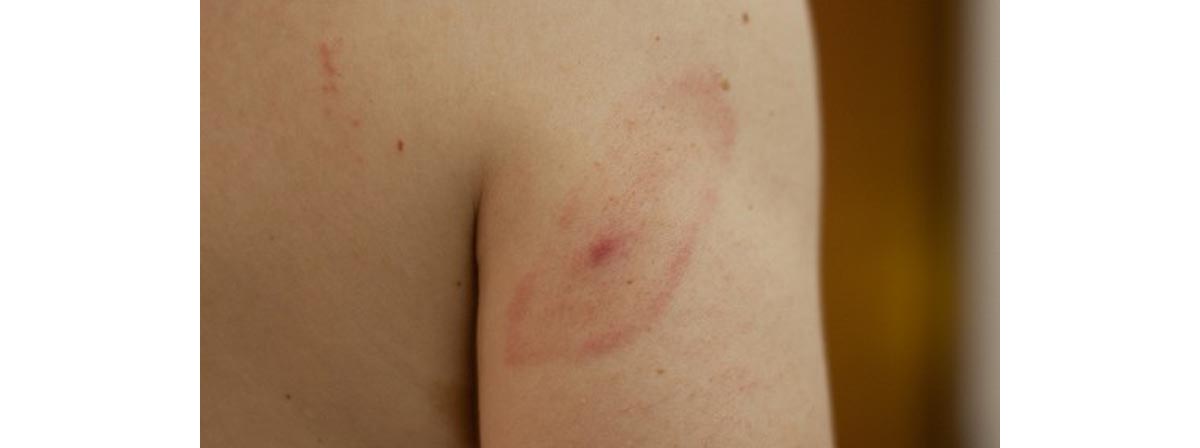Do you enjoy spending time in nature — hiking, exploring woodland, or even going for a picnic in the park? Watch out for ticks. These tiny arachnids feed on mammal blood, and you could be the next target. Ticks can make their way onto your body, latch on, and stick around for days without you even noticing, often by hiding in the very places you'd least want a parasite. That thought is enough to make anyone queasy, but ticks can also transmit Lyme Disease, a nasty bacterial infection with potentially devastating consequences.

What Is Lyme Disease?
Lyme Disease is an infection caused by the bacterium Borrelia Burgdorferi. Various tick species can be carriers of this bacteria, but the black legged tick (also called the deer tick) is the most common one. The disease was named after the village of Old Lyme, Connecticut, where it was first discovered back in 1975. The village's children spent a lot of their time playing outside, and when many got ill, people began to investigate why. Ticks carrying Borrelia Burgdorferi were eventually identified as the cause.
The North East of the United States is a prime example. Why? Some environments are better suited for ticks than others. Climate is an important factor: ticks do best in environments with at least 85 percent humidity that are warmer than 7 degrees Celsius/45 degrees Fahrenheit. The availability of mammal hosts that ticks can feed on is another crucial factor in determining the local tick population. In The North East of the US, mammals like deer and mice are often in close proximity to humans, making them more available to ticks.
In order to understand how Lyme Disease spreads, it is important to be familiar with the tick's life cycle. The tick goes through four stages of life: egg, larva, nymph and adult. After the egg has hatched, a tick will need to feed (potentially on you!) during each life stage in order to continue developing.
A tick's timing is weather-dependent. In Northern-hemisphere countries, larvae will hatch during the early summer and feed shortly thereafter. Once they drop off their host, they will take until late spring of the following year (May, June, and July) to emerge as nymphs. Nymphs tend to target small mammals and birds, but will molt into adults and reappear during the same year. It is adult ticks that usually target large mammals including humans. Adult ticks don't need to hibernate during the winter, which is why you will still need to check your body (and your cat and dog's) for their presence on warm winter days.
Adult ticks are both more likely to target humans and to be infected with B. Burgdorferi; they have, after all, already had two chances to get infected while feeding off a host. They also have one disadvantage. Since adult ticks are bigger than nymphs, you have a better chance of catching them before they manage to feed and infect you. This does take a watchful eye, and if you spend much of your time outdoors in a tick-heavy area, you don't need to ask yourself if you will be bitten by a tick, but rather when. Forest wardens may, for instance, end up with Lyme Disease multiple times per year, despite their best efforts to catch ticks before they latch.
Lyme Disease Symptoms
Lyme Disease shows up as a multi-system inflammatory disease. It has three stages, which each have distinctive symptoms:

-
During stage 1, the infected person may notice a characteristic “bull's eye rash”.
This red rash has a center, surrounded by a larger ring-shaped rash. It usually shows up within a week or two after infection. Flu-like symptoms including stiff joints, muscle and throat aches, swollen lymph nodes and fatigue are also likely to show up during this stage of the disease.
-
Stage 2 is more serious.
Symptoms of stage 2 Lyme Disease include muscle pain, swollen knees and other large joints, and a serious inflammation of the skin around the victim's hands and feet. Weak or paralyzed facial muscles, heart palpitations, fever and disorientation are other symptoms.
-
Stage 3 Lyme Disease can take months or years to set in.
Arthritis of some large joints, numb extremities, and neurological disorders mark this stage of the disease. Expect severe headaches, loss of concentration, memory loss, vision changes, confusion and similar nasty symptoms.
If you think you have Lyme Disease symptoms, you should get in touch with your doctor immediately, even if you are not aware of any tick bites. Pay particular attention to the erythema migrans or “bull's eye” rash, which occurs in the vast majority of infected people — usually, but not always, at the site of the original tick bite. The erythema migrans rash is called a bull's eye rash for a reason, and the migrans part of the name refers to the fact that this is an expanding rash.
See your doctor even if you don't have the bull's eye rash but you do have other symptoms, especially if you live in an endemic area and are an outdoorsy person. If you ignore of fail to recognize early symptoms of Lyme Disease, you could develop more severe symptoms and the disease will be harder to treat.
Diagnosis And Treatment
Lyme Disease is therefore diagnosed on the basis of symptoms, and the bull's eye rash in particular. If you know you have been bitten by a tick and are manifesting symptoms, take action immediately, whether or not you have a rash.
Of course, there are cases in which early symptoms went unnoticed and were attributed to other causes like flu or stress. Later symptoms can appear weeks, months, and even years after initial infection in those cases, and the Centers for Disease Control and Prevention (CDC) recommends the use of ELISA and Western-blot blood tests in that situation.
This test is done through a spinal tap or by removing synovial fluid from an affected joint, and is designed to detect the bacterium's presence.
Late-stage Lyme Disease requires more complex treatment
Oral or IV antibiotics are part of the treatment plan, but other steps may need to be taken depending on the neurological problems and joint complaints a patient experiences. Late-stage Lyme Disease patients may continue to have problems for a long time, and the effects of the disease can even be permanent.
Preventing Lyme Disease
Lyme Disease is a nasty disease to have, whether it is caught in the early stages or develops into stage 3. That is why anyone who may come into contact with ticks — that would be most people, but especially those in endemic areas — should take preventative steps. When you venture into any natural area, you can make yourself and your children a less appealing target for ticks by:

- Wearing closed shoes and tucking pants into socks, or wearing tights. Deer ticks do not jump or drop out of trees, contrary to popular belief. They climb up from grass or bushes. This step will make it harder for a tick to find its way onto your skin.
-
Wearing light-colored clothing to make it easier to spot ticks as they climb upwards.
-
Using an insect repellant that contains diethyl-meta-toluamide, or DEET. You can use this on your skin, or on your clothes.
Frequently scan your clothes for ticks that try to make their way up from your legs in search of skin, and do the same for your children. When you return from your trip, make sure everyone takes a shower. This is the perfect opportunity to wash off any ticks that haven't attached yet, and also to look around for ticks that did manage to attach. Don't forget to look in warm, moist areas like armpits, skin folds and even genitals. Young kids will definitely need your help with spotting ticks.
What do you do if you do find a tick attached to your body, sucking your blood?
Anna, the warden of a nature reserve in Europe, shares her tips: “People used to say that you should grab the tick close to the spot where it bit you, and then twist it. Nowadays, we know that it is best to remove ticks by pulling them upwards while applying a steady, even pressure.
You can do this using your nails, if they are strong and long enough. A pair of fine-tipped tweezers will also do the job."
Being familiar with the symptoms of Lyme Disease, and knowing how to spot ticks, isn't always enough. With her constant exposure to ticks, it was only a matter of time before Anna got infected herself. She says: "I got infected last winter. Increasing fatigue was the first symptom. Suddenly, I noticed a huge bull's eye rash. Recognizing the symptoms, I was able to seek medical attention right away. My doctor did a blood test, which showed up negative. The symptoms persisted and the rash got bigger, so I insisted on getting a course of antibiotics. During that period, I was tested again and the test came back positive.
I made a full recovery relatively quickly, but not everyone is so lucky. My coworker unfortunately also got the disease and developed real joint problems. He was on sick leave for a whole year because of it! He did recover in the end, only to end up with Lyme Disease a second time. Of course, he responded much more quickly then.”
- Photo courtesy of John Tann by Flickr : www.flickr.com/photos/31031835@N08/6368338667/
- Photo courtesy of Stefan Kellner by Flickr : www.flickr.com/photos/skellner/3687318381/
- Photo courtesy of Tom by Picasa : lh6.googleusercontent.com/-A5cs_uEzEk4/TIkRKHqMMLI/AAAAAAAALrI/CW3b2qT9qdM/s1024/P1040593.JPG


Your thoughts on this